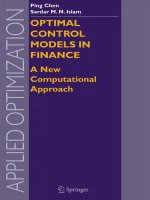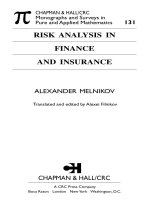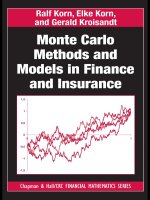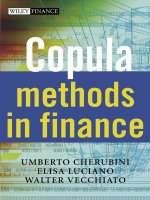Carol quantitative methods in finance
Bạn đang xem bản rút gọn của tài liệu. Xem và tải ngay bản đầy đủ của tài liệu tại đây (3.29 MB, 320 trang )
Market Risk Analysis
Volume I
Quantitative Methods in Finance
Market Risk Analysis
Volume I
Quantitative Methods in Finance
Carol Alexander
Published in 2008 by
John Wiley & Sons Ltd, The Atrium, Southern Gate, Chichester,
West Sussex PO19 8SQ, England
Telephone
+44 1243 779777
Email (for orders and customer service enquiries):
Visit our Home Page on www.wiley.com
Copyright © 2008 Carol Alexander
All Rights Reserved. No part of this publication may be reproduced, stored in a retrieval system or transmitted
in any form or by any means, electronic, mechanical, photocopying, recording, scanning or otherwise, except
under the terms of the Copyright, Designs and Patents Act 1988 or under the terms of a licence issued by the
Copyright Licensing Agency Ltd, 90 Tottenham Court Road, London W1T 4LP, UK, without the permission
in writing of the Publisher. Requests to the Publisher should be addressed to the Permissions Department,
John Wiley & Sons Ltd, The Atrium, Southern Gate, Chichester, West Sussex PO19 8SQ, England, or emailed to
, or faxed to (+44) 1243 770620.
Designations used by companies to distinguish their products are often claimed as trademarks. All brand names
and product names used in this book are trade names, service marks, trademarks or registered trademarks of their
respective owners. The Publisher is not associated with any product or vendor mentioned in this book.
This publication is designed to provide accurate and authoritative information in regard to the subject matter
covered. It is sold on the understanding that the Publisher is not engaged in rendering professional services.
If professional advice or other expert assistance is required, the services of a competent professional should be
sought.
Carol Alexander has asserted her right under the Copyright, Designs and Patents Act 1988, to be identified as the
author of this work.
Other Wiley Editorial Offices
John Wiley & Sons Inc., 111 River Street, Hoboken, NJ 07030, USA
Jossey-Bass, 989 Market Street, San Francisco, CA 94103-1741, USA
Wiley-VCH Verlag GmbH, Boschstr. 12, D-69469 Weinheim, Germany
John Wiley & Sons Australia Ltd, 42 McDougall Street, Milton, Queensland 4064, Australia
John Wiley & Sons (Asia) Pte Ltd, 2 Clementi Loop #02-01, Jin Xing Distripark, Singapore 129809
John Wiley & Sons Canada Ltd, 6045 Freemont Blvd, Mississauga, Ontario, Canada L5R 4J3
Wiley also publishes its books in a variety of electronic formats. Some content that appears in print may not be
available in electronic books.
British Library Cataloguing in Publication Data
A catalogue record for this book is available from the British Library
ISBN 978-0-470-99800-7 (HB)
Typeset in 10/12pt Times by Integra Software Services Pvt. Ltd, Pondicherry, India
Printed and bound in Great Britain by Antony Rowe Ltd, Chippenham, Wiltshire
This book is printed on acid-free paper responsibly manufactured from sustainable forestry
in which at least two trees are planted for each one used for paper production.
To Walter Ledermann
Contents
List of Figures
xiii
List of Tables
xvi
List of Examples
xvii
Foreword
xix
Preface to Volume I
I.1 Basic Calculus for Finance
I.1.1 Introduction
I.1.2 Functions and Graphs, Equations and Roots
I.1.2.1 Linear and Quadratic Functions
I.1.2.2 Continuous and Differentiable Real-Valued Functions
I.1.2.3 Inverse Functions
I.1.2.4 The Exponential Function
I.1.2.5 The Natural Logarithm
I.1.3 Differentiation and Integration
I.1.3.1 Definitions
I.1.3.2 Rules for Differentiation
I.1.3.3 Monotonic, Concave and Convex Functions
I.1.3.4 Stationary Points and Optimization
I.1.3.5 Integration
I.1.4 Analysis of Financial Returns
I.1.4.1 Discrete and Continuous Time Notation
I.1.4.2 Portfolio Holdings and Portfolio Weights
I.1.4.3 Profit and Loss
I.1.4.4 Percentage and Log Returns
I.1.4.5 Geometric Brownian Motion
I.1.4.6 Discrete and Continuous Compounding in Discrete Time
I.1.4.7 Period Log Returns in Discrete Time
I.1.4.8 Return on a Linear Portfolio
I.1.4.9 Sources of Returns
I.1.5 Functions of Several Variables
I.1.5.1 Partial Derivatives: Function of Two Variables
I.1.5.2 Partial Derivatives: Function of Several Variables
xxiii
1
1
3
4
5
6
7
9
10
10
11
13
14
15
16
16
17
19
19
21
22
23
25
25
26
27
27
viii
Contents
I.1.5.3 Stationary Points
I.1.5.4 Optimization
I.1.5.5 Total Derivatives
I.1.6 Taylor Expansion
I.1.6.1 Definition and Examples
I.1.6.2 Risk Factors and their Sensitivities
I.1.6.3 Some Financial Applications of Taylor Expansion
I.1.6.4 Multivariate Taylor Expansion
I.1.7 Summary and Conclusions
I.2 Essential Linear Algebra for Finance
I.2.1 Introduction
I.2.2 Matrix Algebra and its Mathematical Applications
I.2.2.1 Basic Terminology
I.2.2.2 Laws of Matrix Algebra
I.2.2.3 Singular Matrices
I.2.2.4 Determinants
I.2.2.5 Matrix Inversion
I.2.2.6 Solution of Simultaneous Linear Equations
I.2.2.7 Quadratic Forms
I.2.2.8 Definite Matrices
I.2.3 Eigenvectors and Eigenvalues
I.2.3.1 Matrices as Linear Transformations
I.2.3.2 Formal Definitions
I.2.3.3 The Characteristic Equation
I.2.3.4 Eigenvalues and Eigenvectors of a 2 × 2 Correlation
Matrix
I.2.3.5 Properties of Eigenvalues and Eigenvectors
I.2.3.6 Using Excel to Find Eigenvalues and Eigenvectors
I.2.3.7 Eigenvalue Test for Definiteness
I.2.4 Applications to Linear Portfolios
I.2.4.1 Covariance and Correlation Matrices
I.2.4.2 Portfolio Risk and Return in Matrix Notation
I.2.4.3 Positive Definiteness of Covariance and Correlation
Matrices
I.2.4.4 Eigenvalues and Eigenvectors of Covariance and
Correlation Matrices
I.2.5 Matrix Decomposition
I.2.5.1 Spectral Decomposition of a Symmetric Matrix
I.2.5.2 Similarity Transforms
I.2.5.3 Cholesky Decomposition
I.2.5.4 LU Decomposition
I.2.6 Principal Component Analysis
I.2.6.1 Definition of Principal Components
I.2.6.2 Principal Component Representation
I.2.6.3 Case Study: PCA of European Equity Indices
I.2.7 Summary and Conclusions
28
29
31
31
32
33
33
34
35
37
37
38
38
39
40
41
43
44
45
46
48
48
50
51
52
52
53
54
55
55
56
58
59
61
61
62
62
63
64
65
66
67
70
Contents
I.3 Probability and Statistics
I.3.1 Introduction
I.3.2 Basic Concepts
I.3.2.1 Classical versus Bayesian Approaches
I.3.2.2 Laws of Probability
I.3.2.3 Density and Distribution Functions
I.3.2.4 Samples and Histograms
I.3.2.5 Expected Value and Sample Mean
I.3.2.6 Variance
I.3.2.7 Skewness and Kurtosis
I.3.2.8 Quantiles, Quartiles and Percentiles
I.3.3 Univariate Distributions
I.3.3.1 Binomial Distribution
I.3.3.2 Poisson and Exponential Distributions
I.3.3.3 Uniform Distribution
I.3.3.4 Normal Distribution
I.3.3.5 Lognormal Distribution
I.3.3.6 Normal Mixture Distributions
I.3.3.7 Student t Distributions
I.3.3.8 Sampling Distributions
I.3.3.9 Generalized Extreme Value Distributions
I.3.3.10 Generalized Pareto Distribution
I.3.3.11 Stable Distributions
I.3.3.12 Kernels
I.3.4 Multivariate Distributions
I.3.4.1 Bivariate Distributions
I.3.4.2 Independent Random Variables
I.3.4.3 Covariance
I.3.4.4 Correlation
I.3.4.5 Multivariate Continuous Distributions
I.3.4.6 Multivariate Normal Distributions
I.3.4.7 Bivariate Normal Mixture Distributions
I.3.4.8 Multivariate Student t Distributions
I.3.5 Introduction to Statistical Inference
I.3.5.1 Quantiles, Critical Values and Confidence Intervals
I.3.5.2 Central Limit Theorem
I.3.5.3 Confidence Intervals Based on Student t Distribution
I.3.5.4 Confidence Intervals for Variance
I.3.5.5 Hypothesis Tests
I.3.5.6 Tests on Means
I.3.5.7 Tests on Variances
I.3.5.8 Non-Parametric Tests on Distributions
I.3.6 Maximum Likelihood Estimation
I.3.6.1 The Likelihood Function
I.3.6.2 Finding the Maximum Likelihood Estimates
I.3.6.3 Standard Errors on Mean and Variance
Estimates
ix
71
71
72
72
73
75
76
78
79
81
83
85
85
87
89
90
93
94
97
100
101
103
105
106
107
108
109
110
111
114
115
116
117
118
118
120
122
123
124
125
126
127
130
130
131
133
x
Contents
I.3.7 Stochastic Processes in Discrete and Continuous Time
I.3.7.1
Stationary and Integrated Processes in Discrete Time
I.3.7.2
Mean Reverting Processes and Random Walks in
Continuous Time
I.3.7.3
Stochastic Models for Asset Prices and Returns
I.3.7.4
Jumps and the Poisson Process
I.3.8 Summary and Conclusions
I.4 Introduction to Linear Regression
I.4.1 Introduction
I.4.2 Simple Linear Regression
I.4.2.1
Simple Linear Model
I.4.2.2
Ordinary Least Squares
I.4.2.3
Properties of the Error Process
I.4.2.4
ANOVA and Goodness of Fit
I.4.2.5
Hypothesis Tests on Coefficients
I.4.2.6
Reporting the Estimated Regression Model
I.4.2.7
Excel Estimation of the Simple Linear Model
I.4.3 Properties of OLS Estimators
I.4.3.1
Estimates and Estimators
I.4.3.2
Unbiasedness and Efficiency
I.4.3.3
Gauss–Markov Theorem
I.4.3.4
Consistency and Normality of OLS Estimators
I.4.3.5
Testing for Normality
I.4.4 Multivariate Linear Regression
I.4.4.1
Simple Linear Model and OLS in Matrix Notation
I.4.4.2
General Linear Model
I.4.4.3
Case Study: A Multiple Regression
I.4.4.4
Multiple Regression in Excel
I.4.4.5
Hypothesis Testing in Multiple Regression
I.4.4.6
Testing Multiple Restrictions
I.4.4.7
Confidence Intervals
I.4.4.8
Multicollinearity
I.4.4.9
Case Study: Determinants of Credit Spreads
I.4.4.10 Orthogonal Regression
I.4.5 Autocorrelation and Heteroscedasticity
I.4.5.1
Causes of Autocorrelation and Heteroscedasticity
I.4.5.2
Consequences of Autocorrelation and
Heteroscedasticity
I.4.5.3
Testing for Autocorrelation
I.4.5.4
Testing for Heteroscedasticity
I.4.5.5
Generalized Least Squares
I.4.6 Applications of Linear Regression in Finance
I.4.6.1
Testing a Theory
I.4.6.2
Analysing Empirical Market Behaviour
I.4.6.3
Optimal Portfolio Allocation
134
134
136
137
139
140
143
143
144
144
146
148
149
151
152
153
155
155
156
157
157
158
158
159
161
162
163
163
166
167
170
171
173
175
175
176
176
177
178
179
179
180
181
Contents
I.4.6.4
Regression-Based Hedge Ratios
I.4.6.5
Trading on Regression Models
I.4.7 Summary and Conclusions
xi
181
182
184
I.5 Numerical Methods in Finance
I.5.1 Introduction
I.5.2 Iteration
I.5.2.1
Method of Bisection
I.5.2.2
Newton–Raphson Iteration
I.5.2.3
Gradient Methods
I.5.3 Interpolation and Extrapolation
I.5.3.1
Linear and Bilinear Interpolation
I.5.3.2
Polynomial Interpolation: Application to Currency Options
I.5.3.3
Cubic Splines: Application to Yield Curves
I.5.4 Optimization
I.5.4.1
Least Squares Problems
I.5.4.2
Likelihood Methods
I.5.4.3
The EM Algorithm
I.5.4.4
Case Study: Applying the EM Algorithm to Normal Mixture
Densities
I.5.5 Finite Difference Approximations
I.5.5.1
First and Second Order Finite Differences
I.5.5.2
Finite Difference Approximations for the Greeks
I.5.5.3
Finite Difference Solutions to Partial Differential Equations
I.5.6 Binomial Lattices
I.5.6.1
Constructing the Lattice
I.5.6.2
Arbitrage Free Pricing and Risk Neutral Valuation
I.5.6.3
Pricing European Options
I.5.6.4
Lognormal Asset Price Distributions
I.5.6.5
Pricing American Options
I.5.7 Monte Carlo Simulation
I.5.7.1
Random Numbers
I.5.7.2
Simulations from an Empirical or a Given Distribution
I.5.7.3
Case Study: Generating Time Series of Lognormal Asset
Prices
I.5.7.4
Simulations on a System of Two Correlated Normal Returns
I.5.7.5
Multivariate Normal and Student t Distributed
Simulations
I.5.8 Summary and Conclusions
185
185
187
187
188
191
193
193
195
197
200
201
202
203
I.6 Introduction to Portfolio Theory
I.6.1 Introduction
I.6.2 Utility Theory
I.6.2.1
Properties of Utility Functions
I.6.2.2
Risk Preference
I.6.2.3
How to Determine the Risk Tolerance of an Investor
I.6.2.4
Coefficients of Risk Aversion
225
225
226
226
229
230
231
203
206
206
207
208
210
211
211
212
213
215
217
217
217
218
220
220
223
xii
Contents
I.6.2.5
I.6.2.6
I.6.2.7
I.6.3
I.6.4
I.6.5
I.6.6
Some Standard Utility Functions
Mean–Variance Criterion
Extension of the Mean–Variance Criterion to
Higher Moments
Portfolio Allocation
I.6.3.1
Portfolio Diversification
I.6.3.2
Minimum Variance Portfolios
I.6.3.3
The Markowitz Problem
I.6.3.4
Minimum Variance Portfolios with Many Constraints
I.6.3.5
Efficient Frontier
I.6.3.6
Optimal Allocations
Theory of Asset Pricing
I.6.4.1
Capital Market Line
I.6.4.2
Capital Asset Pricing Model
I.6.4.3
Security Market Line
I.6.4.4
Testing the CAPM
I.6.4.5
Extensions to CAPM
Risk Adjusted Performance Measures
I.6.5.1
CAPM RAPMs
I.6.5.2
Making Decisions Using the Sharpe Ratio
I.6.5.3
Adjusting the Sharpe Ratio for Autocorrelation
I.6.5.4
Adjusting the Sharpe Ratio for Higher Moments
I.6.5.5
Generalized Sharpe Ratio
I.6.5.6
Kappa Indices, Omega and Sortino Ratio
Summary and Conclusions
232
234
235
237
238
240
244
245
246
247
250
250
252
253
254
255
256
257
258
259
260
262
263
266
References
269
Statistical Tables
273
Index
279
List of Figures
A linear function
The quadratic function
f x = 4x2 + 3x + 2
I.1.3 The reciprocal function
I.1.4 The inverse of a function
I.1.5 The exponential function
I.1.6 The natural logarithmic
function
I.1.7 Definition of the first
derivative
I.1.8 Two functions
I.1.9 The definite integral
I.1.10 The h-period log return is
the sum of h consecutive
one-period log returns
I.1.11 Graph of the function in
Example I.1.8
I.2.1 A matrix is a linear
transformation
I.2.2 A vector that is not an
eigenvector
I.2.3 An eigenvector
I.2.4 Six European equity indices
I.2.5 The first principal
component
I.3.1 Venn diagram
I.3.2 Density and distribution
functions: (a) discrete
random variable; (b)
continuous variable
I.3.3 Building a histogram in
Excel
I.3.4 The effect of cell width on
the histogram shape
I.3.5 Two densities with
the same expectation
I.1.1
I.1.2
4
5
6
7
8
I.3.6
9
I.3.8
10
12
15
I.3.9
24
27
I.3.7
I.3.10
I.3.11
I.3.12
I.3.13
48
I.3.14
49
50
67
I.3.15
I.3.16
69
75
I.3.17
77
78
I.3.18
78
I.3.19
I.3.20
but different standard
deviations
(a) A normal density and a
leptokurtic density; (b) a
positively skewed density
The 0.1 quantile of a
continuous random variable
Some binomial density
functions
A binomial tree for a stock
price evolution
The standard uniform
distribution
Two normal densities
Lognormal density
associated with the standard
normal distribution
A variance mixture of two
normal densities
A skewed, leptokurtic
normal mixture density
Comparison of Student t
densities and standard
normal
Comparison of Student t
density and normal with
same variance
Comparison of standardized
empirical density with
standardized Student t
density and standard
normal density
The Excel t distribution
function
Filtering data to derive the
GEV distribution
A Fréchet density
80
83
84
86
87
89
90
93
95
97
98
99
99
100
102
103
xiv
List of Figures
I.3.21 Filtering data in the
peaks-over-threshold
model
I.3.22 Kernel estimates of S&P
500 returns
I.3.23 Scatter plots from a
paired sample of returns:
(a) correlation +0 75;
(b) correlation 0;
(c) correlation −0 75
I.3.24 Critical regions for
hypothesis tests
I.3.25 The dependence of the
likelihood on parameters
I.3.26 The likelihood and the log
likelihood functions
I.3.27 FTSE 100 index
I.3.28 Daily prices and log prices
of DJIA index
I.3.29 Daily log returns on DJIA
index
I.4.1 Scatter plot of Amex and
S&P 500 daily log returns
I.4.2 Dialog box for Excel
regression
I.4.3 Unbiasedness and
efficiency
I.4.4 Distribution of a consistent
estimator
I.4.5 Billiton share price, Amex
Oil index and CBOE Gold
index
I.4.6 Dialog box for multiple
regression in Excel
I.4.7 The iTraxx Europe index
and its determinants
I.4.8 Residuals from the Billiton
regression
I.5.1 Method of bisection
I.5.2 Setting Excel’s Goal Seek
I.5.3 Newton–Raphson iteration
I.5.4
104
107
I.5.5
I.5.6
I.5.7
I.5.8
I.5.9
113
I.5.10
125
I.5.11
130
I.5.12
131
133
I.5.13
I.5.14
137
138
I.5.15
I.5.16
145
I.5.17
153
I.5.18
156
I.5.19
157
I.5.20
162
I.6.1
164
I.6.2
172
I.6.3
178
187
189
189
I.6.4
I.6.5
Convergence of
Newton–Raphson
scheme
Solver options
Extrapolation of a yield
curve
Linear interpolation on
percentiles
Fitting a currency smile
A cubic spline interpolated
yield curve
FTSE 100 and S&P 500
index prices, 1996–2007
Sterling–US dollar
exchange rate, 1996–2007
Slope of chord about a
point
Discretization of space for
the finite difference scheme
A simple finite difference
scheme
A binomial lattice
Computing the price of
European and American
puts
Simulating from a standard
normal distribution
Possible paths for an asset
price following geometric
Brownian motion
A set of three independent
standard normal
simulations
A set of three correlated
normal simulations
Convex, concave and linear
utility functions
The effect of correlation on
portfolio volatility
Portfolio volatility as a
function of portfolio weight
Portfolio risk and return as
a function of portfolio
weight
Minimum variance
portfolio
190
191
193
195
197
200
204
204
206
209
210
210
216
218
220
221
222
229
239
241
242
243
I.6.6
I.6.7
I.6.8
Solver settings for
Example I.6.9
The opportunity set and the
efficient frontier
Indifference curves of risk
averse investor
List of Figures
xv
Indifference curves of risk
loving investor
I.6.10 Market portfolio
I.6.11 Capital market line
I.6.12 Security market line
249
251
251
253
I.6.9
246
247
248
List of Tables
I.1.1 Asset prices
I.1.2 Portfolio weights and
portfolio value
I.1.3 Portfolio returns
I.2.1 Volatilities and correlations
I.2.2 The correlation matrix of
weekly returns
I.2.3 Eigenvectors and
eigenvalues of the
correlation matrix
I.3.1 Example of the density of a
discrete random variable
I.3.2 Distribution function for
Table I.3.1
I.3.3 Biased and unbiased sample
moments
I.3.4 The B(3, 1/6) distribution
I.3.5 A Poisson density function
I.3.6 A simple bivariate density
I.3.7 Distribution of the product
I.3.8 Calculating a covariance
I.3.9 Sample statistics
I.4.1 Calculation of OLS
estimates
I.4.2 Estimating the residual sum
of sqaures and the standard
error of the regression
I.4.3 Estimating the total sum of
squares
I.4.4 Critical values of t3
I.4.5 Some of the Excel output for
the Amex and S&P 500
model
18
18
26
56
68
68
75
75
82
86
88
110
110
111
127
147
149
150
152
154
I.4.6 ANOVA for the Amex and
S&P 500 model
I.4.7 Coefficient estimates for the
Amex and S&P 500 model
I.4.8 ANOVA for Billiton
regression
I.4.9 Wald, LM and LR statistics
I.5.1 Mean and volatility of the
FTSE 100 and S&P 500
indices and the £/$ FX rate
I.5.2 Estimated parameters of
normal mixture distributions
I.5.3 Analytic vs finite difference
Greeks
I.5.4 Characteristics of asset
returns
I.6.1 Two investments (outcomes
as returns)
I.6.2 Two investments (utility of
outcomes)
I.6.3 Returns characteristics for
two portfolios
I.6.4 Two investments
I.6.5 Sharpe ratio and weak
stochastic dominance
I.6.6 Returns on an actively
managed fund and its
benchmark
I.6.7 Statistics on excess returns
I.6.8 Sharpe ratios and adjusted
Sharpe ratios
I.6.9 Kappa indices
154
154
164
167
205
205
208
221
227
228
237
258
259
261
262
262
264
List of Examples
I.1.1
I.1.2
I.1.3
I.1.4
I.1.5
I.1.6
I.1.7
I.1.8
I.1.9
I.1.10
I.1.11
I.2.1
I.2.2
I.2.3
I.2.4
I.2.5
I.2.6
I.2.7
I.2.8
I.2.9
I.2.10
I.2.11
Roots of a quadratic
equation
Calculating derivatives
Identifying stationary points
A definite integral
Portfolio weights
Returns on a long-short
portfolio
Portfolio returns
Stationary points of a
function of two variables
Constrained optimization
Total derivative of a
function of three variables
Taylor approximation
Finding a matrix product
using Excel
Calculating a 4 × 4
determinant
Finding the determinant
and the inverse matrix
using Excel
Solving a system of
simultaneous linear
equations in Excel
A quadratic form in Excel
Positive definiteness
Determinant test for
positive definiteness
Finding eigenvalues and
eigenvectors
Finding eigenvectors
Using an Excel add-in to
find eigenvectors and
eigenvalues
Covariance and correlation
matrices
5
12
14
16
18
20
25
28
30
31
32
40
42
43
45
45
46
47
51
53
54
56
I.2.12 Volatility of returns and
volatility of P&L
I.2.13 A non-positive definite
3 × 3 matrix
I.2.14 Eigenvectors and
eigenvalues of a 2 × 2
covariance matrix
I.2.15 Spectral decomposition of a
correlation matrix
I.2.16 The Cholesky matrix of a
2 × 2 matrix
I.2.17 The Cholesky matrix of a
3 × 3 matrix
I.2.18 Finding the Cholesky
matrix in Excel
I.2.19 Finding the LU
decomposition in Excel
I.3.1 Building a histogram
I.3.2 Calculating moments of a
distribution
I.3.3 Calculating moments of a
sample
I.3.4 Evolution of an asset price
I.3.5 Normal probabilities
I.3.6 Normal probabilities for
portfolio returns
I.3.7 Normal probabilities for
active returns
I.3.8 Variance and kurtosis of a
zero-expectation normal
mixture
I.3.9 Probabilities of normal
mixture variables
I.3.10 Calculating a covariance
I.3.11 Calculating a correlation
I.3.12 Normal confidence intervals
57
59
60
61
62
63
63
64
77
81
82
87
90
91
92
95
96
110
112
119
xviii
List of Examples
I.3.13 One- and two-sided
confidence intervals
I.3.14 Confidence interval for a
population mean
I.3.15 Testing for equality of
means and variances
I.3.16 Log likelihood of the
normal density
I.3.17 Fitting a Student t
distribution by maximum
likelihood
I.4.1 Using the OLS formula
I.4.2 Relationship between beta
and correlation
I.4.3 Estimating the OLS
standard error of the
regression
I.4.4 ANOVA
I.4.5 Hypothesis tests in a simple
linear model
I.4.6 Simple regression in matrix
form
I.4.7 Goodness-of-fit test in
multiple regression
I.4.8 Testing a simple hypothesis
in multiple regression
I.4.9 Testing a linear restriction
I.4.10 Confidence interval for
regression coefficient
I.4.11 Prediction in multivariate
regression
I.4.12 Durbin–Watson test
I.4.13 White’s heteroscedasticity
test
I.5.1 Excel’s Goal Seek
I.5.2 Using Solver to find a bond
yield
I.5.3 Interpolating implied
volatility
I.5.4 Bilinear interpolation
I.5.5
120
I.5.6
123
I.5.7
127
131
I.5.8
I.5.9
132
147
147
148
150
151
160
I.5.10
I.6.1
I.6.2
I.6.3
I.6.4
I.6.5
I.6.6
164
165
165
168
I.6.7
I.6.8
I.6.9
169
177
I.6.10
I.6.11
177
188
I.6.12
191
I.6.13
I.6.14
194
194
I.6.15
Fitting a 25-delta currency
option smile
Interpolation with cubic
splines
Finite difference
approximation to delta,
gamma and vega
Pricing European call and
put options
Pricing an American option
with a binomial lattice
Simulations from correlated
Student t distributed
variables
Expected utility
Certain equivalents
Portfolio allocations for an
exponential investor
Higher moment criterion
for an exponential investor
Minimum variance
portfolio: two assets
Minimum variance
portfolio on S&P 100 and
FTSE 100
General formula for
minimum variance portfolio
The Markowitz problem
Minimum variance
portfolio with many
constraints
The CML equation
Stochastic dominance and
the Sharpe ratio
Adjusting a Sharpe ratio for
autocorrelation
Adjusted Sharpe ratio
Computing a generalized
Sharpe ratio
Omega, Sortino and kappa
indices
196
198
208
212
215
222
227
228
235
236
241
242
244
245
246
252
258
260
261
263
264
Foreword
How many children dream of one day becoming risk managers? I very much doubt little
Carol Jenkins, as she was called then, did. She dreamt about being a wild white horse, or a
mermaid swimming with dolphins, as any normal little girl does. As I start crunching into
two kilos of Toblerone that Carol Alexander-Pézier gave me for Valentine’s day (perhaps to
coax me into writing this foreword), I see the distinctive silhouette of the Matterhorn on the
yellow package and I am reminded of my own dreams of climbing mountains and travelling
to distant planets. Yes, adventure and danger! That is the stuff of happiness, especially when
you daydream as a child with a warm cup of cocoa in your hands.
As we grow up, dreams lose their naivety but not necessarily their power. Knowledge
makes us discover new possibilities and raises new questions. We grow to understand better
the consequences of our actions, yet the world remains full of surprises. We taste the
sweetness of success and the bitterness of failure. We grow to be responsible members of
society and to care for the welfare of others. We discover purpose, confidence and a role to
fulfil; but we also find that we continuously have to deal with risks.
Leafing through the hundreds of pages of this four-volume series you will discover one
of the goals that Carol gave herself in life: to set the standards for a new profession, that of
market risk manager, and to provide the means of achieving those standards. Why is market
risk management so important? Because in our modern economies, market prices balance
the supply and demand of most goods and services that fulfil our needs and desires. We can
hardly take a decision, such as buying a house or saving for a later day, without taking some
market risks. Financial firms, be they in banking, insurance or asset management, manage
these risks on a grand scale. Capital markets and derivative products offer endless ways to
transfer these risks among economic agents.
But should market risk management be regarded as a professional activity? Sampling the
material in these four volumes will convince you, if need be, of the vast amount of knowledge
and skills required. A good market risk manager should master the basics of calculus,
linear algebra, probability – including stochastic calculus – statistics and econometrics. He
should be an astute student of the markets, familiar with the vast array of modern financial
instruments and market mechanisms, and of the econometric properties of prices and returns
in these markets. If he works in the financial industry, he should also be well versed in
regulations and understand how they affect his firm. That sets the academic syllabus for the
profession.
Carol takes the reader step by step through all these topics, from basic definitions and
principles to advanced problems and solution methods. She uses a clear language, realistic
illustrations with recent market data, consistent notation throughout all chapters, and provides
a huge range of worked-out exercises on Excel spreadsheets, some of which demonstrate
xx
Foreword
analytical tools only available in the best commercial software packages. Many chapters on
advanced subjects such as GARCH models, copulas, quantile regressions, portfolio theory,
options and volatility surfaces are as informative as and easier to understand than entire
books devoted to these subjects. Indeed, this is the first series of books entirely dedicated to
the discipline of market risk analysis written by one person, and a very good teacher at that.
A profession, however, is more than an academic discipline; it is an activity that fulfils
some societal needs, that provides solutions in the face of evolving challenges, that calls for
a special code of conduct; it is something one can aspire to. Does market risk management
face such challenges? Can it achieve significant economic benefits?
As market economies grow, more ordinary people of all ages with different needs and
risk appetites have financial assets to manage and borrowings to control. What kind of
mortgages should they take? What provisions should they make for their pensions? The range
of investment products offered to them has widened far beyond the traditional cash, bond
and equity classes to include actively managed funds (traditional or hedge funds), private
equity, real estate investment trusts, structured products and derivative products facilitating
the trading of more exotic risks – commodities, credit risks, volatilities and correlations,
weather, carbon emissions, etc. – and offering markedly different return characteristics from
those of traditional asset classes. Managing personal finances is largely about managing
market risks. How well educated are we to do that?
Corporates have also become more exposed to market risks. Beyond the traditional exposure to interest rate fluctuations, most corporates are now exposed to foreign exchange risks
and commodity risks because of globalization. A company may produce and sell exclusively
in its domestic market and yet be exposed to currency fluctuations because of foreign competition. Risks that can be hedged effectively by shareholders, if they wish, do not have
to be hedged in-house. But hedging some risks in-house may bring benefits (e.g. reduction
of tax burden, smoothing of returns, easier planning) that are not directly attainable by the
shareholder.
Financial firms, of course, should be the experts at managing market risks; it is their
métier. Indeed, over the last generation, there has been a marked increase in the size of
market risks handled by banks in comparison to a reduction in the size of their credit risks.
Since the 1980s, banks have provided products (e.g. interest rate swaps, currency protection,
index linked loans, capital guaranteed investments) to facilitate the risk management of their
customers. They have also built up arbitrage and proprietary trading books to profit from
perceived market anomalies and take advantage of their market views. More recently, banks
have started to manage credit risks actively by transferring them to the capital markets
instead of warehousing them. Bonds are replacing loans, mortgages and other loans are
securitized, and many of the remaining credit risks can now be covered with credit default
swaps. Thus credit risks are being converted into market risks.
The rapid development of capital markets and, in particular, of derivative products bears
witness to these changes. At the time of writing this foreword, the total notional size of all
derivative products exceeds $500 trillion whereas, in rough figures, the bond and money
markets stand at about $80 trillion, the equity markets half that and loans half that again.
Credit derivatives by themselves are climbing through the $30 trillion mark. These derivative
markets are zero-sum games; they are all about market risk management – hedging, arbitrage
and speculation.
This does not mean, however, that all market risk management problems have been
resolved. We may have developed the means and the techniques, but we do not necessarily
Foreword
xxi
understand how to address the problems. Regulators and other experts setting standards and
policies are particularly concerned with several fundamental issues. To name a few:
1. How do we decide what market risks should be assessed and over what time horizons?
For example, should the loan books of banks or long-term liabilities of pension funds
be marked to market, or should we not be concerned with pricing things that will not
be traded in the near future? We think there is no general answer to this question
about the most appropriate description of risks. The descriptions must be adapted to
specific management problems.
2. In what contexts should market risks be assessed? Thus, what is more risky, fixed or
floating rate financing? Answers to such questions are often dictated by accounting
standards or other conventions that must be followed and therefore take on economic
significance. But the adequacy of standards must be regularly reassessed. To wit,
the development of International Accounting Standards favouring mark-to-market and
hedge accounting where possible (whereby offsetting risks can be reported together).
3. To what extent should risk assessments be ‘objective’? Modern regulations of financial
firms (Basel II Amendment, 1996) have been a major driver in the development of risk
assessment methods. Regulators naturally want a ‘level playing field’ and objective
rules. This reinforces a natural tendency to assess risks purely on the basis of statistical
evidence and to neglect personal, forward-looking views. Thus one speaks too often
about risk ‘measurements’ as if risks were physical objects instead of risk ‘assessments’
indicating that risks are potentialities that can only be guessed by making a number
of assumptions (i.e. by using models). Regulators try to compensate for this tendency
by asking risk managers to draw scenarios and to stress-test their models.
There are many other fundamental issues to be debated, such as the natural tendency to
focus on micro risk management – because it is easy – rather than to integrate all significant
risks and to consider their global effect – because that is more difficult. In particular, the
assessment and control of systemic risks by supervisory authorities is still in its infancy.
But I would like to conclude by calling attention to a particular danger faced by a nascent
market risk management profession, that of separating risks from returns and focusing on
downside-risk limits.
It is central to the ethics of risk managers to be independent and to act with integrity. Thus
risk managers should not be under the direct control of line managers of profit centres and
they should be well remunerated independently of company results. But in some firms this
is also understood as denying risk managers access to profit information. I remember a risk
commission that had to approve or reject projects but, for internal political reasons, could
not have any information about their expected profitability. For decades, credit officers in
most banks operated under such constraints: they were supposed to accept or reject deals
a priori, without knowledge of their pricing. Times have changed. We understand now, at
least in principle, that the essence of risk management is not simply to reduce or control
risks but to achieve an optimal balance between risks and returns.
Yet, whether for organizational reasons or out of ignorance, risk management is often
confined to setting and enforcing risk limits. Most firms, especially financial firms, claim to
have well-thought-out risk management policies, but few actually state trade-offs between
risks and returns. Attention to risk limits may be unwittingly reinforced by regulators. Of
course it is not the role of the supervisory authorities to suggest risk–return trade-offs; so
supervisors impose risk limits, such as value at risk relative to capital, to ensure safety and
xxii
Foreword
fair competition in the financial industry. But a regulatory limit implies severe penalties
if breached, and thus a probabilistic constraint acquires an economic value. Banks must
therefore pay attention to the uncertainty in their value-at-risk estimates. The effect would
be rather perverse if banks ended up paying more attention to the probability of a probability
than to their entire return distribution.
With Market Risk Analysis readers will learn to understand these long-term problems
in a realistic context. Carol is an academic with a strong applied interest. She has helped
to design the curriculum for the Professional Risk Managers’ International Association
(PRMIA) qualifications, to set the standards for their professional qualifications, and she
maintains numerous contacts with the financial industry through consulting and seminars.
In Market Risk Analysis theoretical developments may be more rigorous and reach a more
advanced level than in many other books, but they always lead to practical applications
with numerous examples in interactive Excel spreadsheets. For example, unlike 90% of the
finance literature on hedging that is of no use to practitioners, if not misleading at times,
her concise expositions on this subject give solutions to real problems.
In summary, if there is any good reason for not treating market risk management as a
separate discipline, it is that market risk management should be the business of all decision
makers involved in finance, with primary responsibilities on the shoulders of the most senior
managers and board members. However, there is so much to be learnt and so much to be
further researched on this subject that it is proper for professional people to specialize in
it. These four volumes will fulfil most of their needs. They only have to remember that,
to be effective, they have to be good communicators and ensure that their assessments are
properly integrated in their firm’s decision-making process.
Jacques Pézier
Preface to Volume I
Financial risk management is a new quantitative discipline. Its development began during
the 1970s, spurred on by the first Basel Accord, between the G10 countries, which covered
the regulation of banking risk. Over the past 30 years banks have begun to understand the
risks they take, and substantial progress has been made, particularly in the area of market
risks. Here the availability of market data and the incentive to reduce regulatory capital
charges through proper assessment of risks has provided a catalyst to the development of
market risk management software. Nowadays this software is used not only by banks, but
also by asset managers, hedge funds, insurance firms and corporate treasurers.
Understanding market risk is the first step towards managing market risk. Yet, despite
the progress that has been made over the last 30 years, there is still a long way to go
before even the major banks and other large financial institutions will really know their
risks. At the time of writing there is a substantial barrier to progress in the profession, which
is the refusal by many to acknowledge just how mathematical a subject risk management
really is.
Asset management is an older discipline than financial risk management, yet it remains at
a less advanced stage of quantitative development. Unfortunately the terms ‘equity analyst’,
‘bond analyst’ and more generally ‘financial analyst’ are something of a misnomer, since
little analysis in the mathematical sense is required for these roles. I discovered this to my
cost when I took a position as a ‘bond analyst’ after completing a postdoctoral fellowship
in algebraic number theory.
One reason for the lack of rigorous quantitative analysis amongst asset managers is
that, traditionally, managers were restricted to investing in cash equities or bonds, which
are relatively simple to analyse compared with swaps, options and other derivatives. Also
regulators have set few barriers to entry. Almost anyone can set up an asset management
company or hedge fund, irrespective of their quantitative background, and risk-based capital
requirements are not imposed. Instead the risks are borne by the investors, not the asset
manager or hedge fund.
The duty of the fund manager is to be able to describe the risks to their investors accurately.
Fund managers have been sued for not doing this properly. But a legal threat has less impact
on good practice than the global regulatory rules that are imposed on banks, and this is why
risk management in banking has developed faster than it has in asset management. Still, there
is a very long way to go in both professions before a firm could claim that it has achieved
‘best practice’ in market risk assessment, despite the claims that are currently made.
At the time of writing there is a huge demand for properly qualified financial risk managers
and asset managers, and this book represents the first step towards such qualification. With
this book readers will master the basics of the mathematical subjects that lay the foundations









